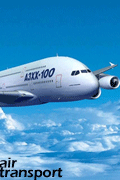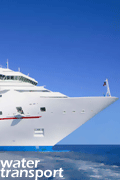Thursday, October 9, 2008
NORFOLK, VA - The federal government will establish a new national network of marine highways to help move cargo across the country in order to cut congestion on some of the nation's busiest highways, announced U.S. Deputy Secretary of Transportation Thomas Barrett today.
The Department's "Marine Highways" initiative calls for the selection and designation of key maritime inland and coastal maritime corridors as marine highways, the Admiral said. These routes will be eligible for up to $25 million in existing federal capital construction funds, he noted, and ensures that these communities will continue to qualify for up to $1.7 billion in federal highway congestion mitigation and air quality (CMAQ) funds.
"This initiative does more than simply add new lines to a map," said Deputy Secretary Barrett. "It makes our roads safer, expands our capacity for moving goods and reflects the kind of 21st century innovation we are going to need to be competitive in today’s global marketplace."
The Deputy Secretary noted that the initiative makes it easier for companies to take advantage of the new maritime routes by providing businesses with assistance in locating shippers willing to move goods by water.
"These highways have no stoplights, traffic or potholes," said Deputy Secretary Barrett. "Sometimes transportation solutions require new concrete, but other times the answer is as simple as using existing water."
Admiral Barrett announced the new initiative, which is outlined in an interim final rule, during a visit to the Norfolk, Va., based James River Barge Line. The new service plans to move cargo up the James River to Richmond, shifting more than 4,000 trucks-worth of cargo off nearby I-64 and onto the waterway.
Deputy Secretary Barrett said the interim final rule is available for review at http://federalregister.gov/OFRUpload/OFRData/2008-23834_PI.pdf and would go into effect after a 120-day comment period.
The Department's "Marine Highways" initiative calls for the selection and designation of key maritime inland and coastal maritime corridors as marine highways, the Admiral said. These routes will be eligible for up to $25 million in existing federal capital construction funds, he noted, and ensures that these communities will continue to qualify for up to $1.7 billion in federal highway congestion mitigation and air quality (CMAQ) funds.
"This initiative does more than simply add new lines to a map," said Deputy Secretary Barrett. "It makes our roads safer, expands our capacity for moving goods and reflects the kind of 21st century innovation we are going to need to be competitive in today’s global marketplace."
The Deputy Secretary noted that the initiative makes it easier for companies to take advantage of the new maritime routes by providing businesses with assistance in locating shippers willing to move goods by water.
"These highways have no stoplights, traffic or potholes," said Deputy Secretary Barrett. "Sometimes transportation solutions require new concrete, but other times the answer is as simple as using existing water."
Admiral Barrett announced the new initiative, which is outlined in an interim final rule, during a visit to the Norfolk, Va., based James River Barge Line. The new service plans to move cargo up the James River to Richmond, shifting more than 4,000 trucks-worth of cargo off nearby I-64 and onto the waterway.
Deputy Secretary Barrett said the interim final rule is available for review at http://federalregister.gov/OFRUpload/OFRData/2008-23834_PI.pdf and would go into effect after a 120-day comment period.
posted by transport blogs
@ 9:45 PM
permanent link | Post a Comment
|
![]()








